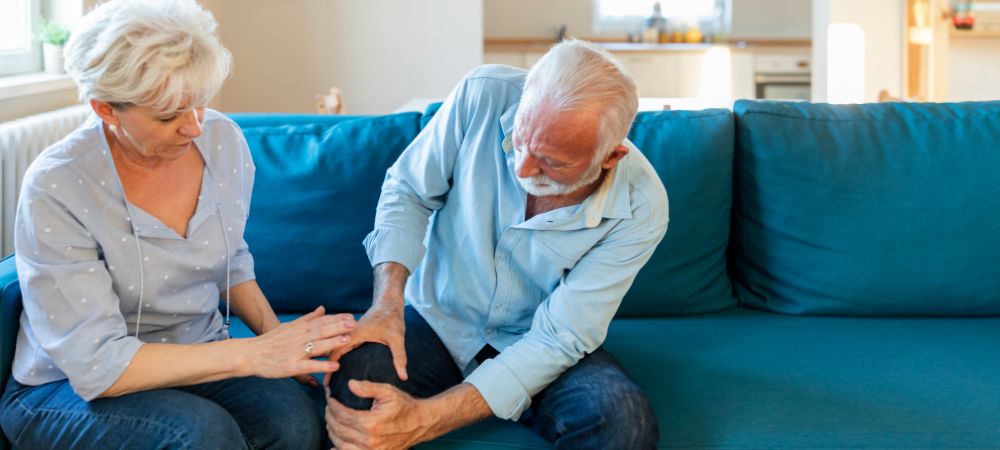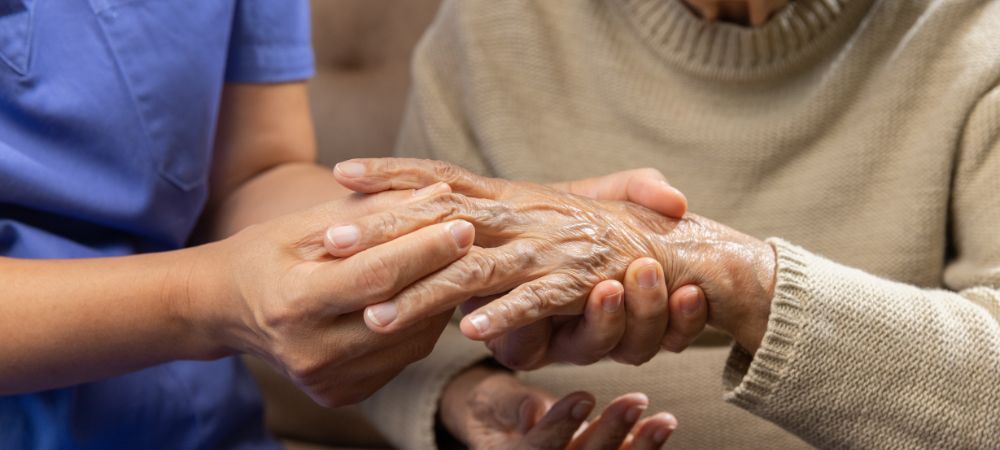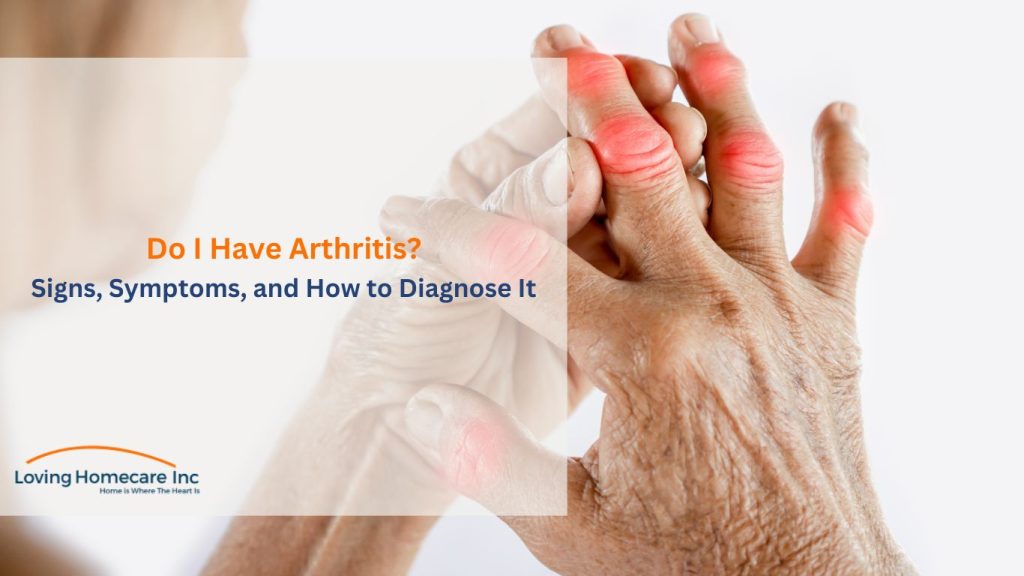Recently updated on October 2nd, 2025 at 06:38 am
If you’re wondering how to know I have arthritis, your doctor may recommend several arthritis diagnosis tests. For that, you need to understand and recognize the symptoms of arthritis.
Your healthcare provider can help you determine the type of arthritis you have, what is causing it, and the best ways to manage it.
What Is Arthritis?

Arthritis is a condition that causes pain, stiffness, and inflammation in the joints. It can affect people of all ages, including children and seniors.
Arthritis can develop in any joint, but most commonly affects the hands, knees, hips, and spine. If you’re experiencing persistent joint pain that interferes with daily activities or limits movement, it’s important to consult a healthcare provider.
If you or a loved one is dealing with arthritis, the trained caregivers at Loving Homecare can help with daily activities, medication management, and personalized care plans.
What are the Common Types of Arthritis?
There are many types of arthritis, but some of the most common include:
- Osteoarthritis Arthritis: It is caused by years of wear and tear on the joints.
- Rheumatoid Arthritis: It happens when the immune system mistakenly attacks the joints.
- Gout: It is caused by a buildup of uric acid crystals in the joints, leading to pain and swelling.
- Ankylosing spondylitis: It is a type of arthritis that mainly affects the spine and lower back.
- Psoriatic arthritis: It is a type of arthritis that affects people with psoriasis, a skin condition.
- Juvenile arthritis: It is a form of arthritis that affects children and teenagers.
Early Signs and Symptoms of Arthritis
Are you experiencing unexplained joint pain or stiffness? Here are the early signs of arthritis to watch for.
- Joint pain that worsens after activity or rest
- Swelling and tenderness around the joints
- Reduced range of motion
- Warmth and redness in the affected area
- Morning stiffness lasting longer than 30 minutes
How to Know If I Have Arthritis in My Hands, Fingers, or Knees?

Different types of arthritis affect different parts of the body. Here is what to look for:
How to Know If I Have Arthritis in My Hands?
Do your hands feel stiff, swollen, or weak?
Arthritis vs. Tendonitis
- Tendonitis: Inflammation of the tendons from injury or overuse. Pain comes and goes.
- Arthritis: Joint inflammation caused by wear and tear (osteoarthritis) or an immune system attack (rheumatoid arthritis). Pain is persistent and worsens over time.
Symptoms of Arthritis in Hands
- Ongoing pain in hands, fingers, or wrists
- Swelling and stiffness, especially in the morning
- Weak grip strength and reduced movement
Our caregivers provide respectful help for seniors with arthritis at home, ensuring that even daily tasks like dressing or grooming are handled with dignity.
How to Know If I Have Arthritis in My Fingers?
If you’re wondering what arthritis feels like in fingers, people often describe finger arthritis as a dull, burning pain with swelling and stiffness:
- Pain: A dull, burning pain, especially after using your hands.
- Swelling: Joints may become puffy, red, and sore.
- Stiffness: Difficulty moving fingers, especially in the morning.
- Warmth: Inflamed joints may feel warm to the touch.
- Weak grip: Trouble opening jars, turning keys, or grasping objects.
- Bumps: Small lumps (Heberden’s or Bouchard’s nodes) may form on fingers.
- Bent fingers: Severe arthritis can lead to joint deformities like Boutonniere deformity.
Our caregivers can step in with gentle, respectful assistance for these daily activities, helping your loved one maintain dignity while avoiding unnecessary pain.
How to Know If I Have Arthritis in My Knee?
Arthritis in the knee causes pain, swelling, and stiffness. Here are the most common arthritis in knees symptoms to look for.
- Pain: Aching or sharp pain, especially during movement or after activity.
- Swelling: The knee may become puffy and tender due to inflammation.
- Stiffness: Limited movement, especially in the morning or after sitting for a long time.
- Weakness: Difficulty standing up or climbing stairs.
- Popping or cracking sounds: Damaged cartilage may cause noises when moving.
- Warmth and redness: The knee may feel warm due to inflammation.
Our caregivers for elderly with arthritis assist with safe transfers, stair navigation, and household chores when knee arthritis flares up.
Arthritis in knees can be of different types, including:
- Osteoarthritis: It is the most common type, which is caused by cartilage wear and tear.
- Rheumatoid arthritis: It is an autoimmune disease that attacks knee joints.
- Juvenile idiopathic arthritis: It is the most common arthritis in children, affecting knee joints.
How to Get an Arthritis Diagnosis? What to Expect
If you think that you have arthritis, you need to get a diagnosis. Here is what your doctor may do:
- Physical Exam: Your doctor may start with a physical examination. He would check for swelling, redness, and restrictions in joint movement.
- Imaging Tests: Later on, he would get X-rays, MRIs, or CT scans to assess joint damage
- Blood Tests: A proper rheumatoid arthritis diagnosis often involves blood tests and imaging to confirm joint inflammation and rule out other causes.
- Joint Fluid Analysis: Your doctor would also conduct joint fluid analysis to identify signs of infection or gout.
Receiving an arthritis diagnosis can feel overwhelming, but you don’t have to face it alone. Loving Homecare offers free consultations to design a personalized care plan that supports your comfort and independence at home.
How to Know if I Have Rheumatoid Arthritis?

Rheumatoid arthritis (RA) is a disease that causes pain, swelling, and stiffness in the joints. It can also affect other body parts, like the eyes, heart, and lungs.
Common Signs of RA
- Swollen, tender joints often in the hands, feet, and wrists.
- Stiffness in the morning that lasts 30 minutes or more.
- Tiredness and weight loss caused by inflammation.
- Pain is present on both sides of the body, for example, knees and wrists.
Other Possible Symptoms
- Dry eyes and mouth.
- Lumps under the skin (rheumatoid nodules).
- Trouble breathing or chest pain.
When Should You See a Doctor for Joint Pain?
If joint pain is persistent, worsens over time, or is accompanied by swelling and stiffness, see a doctor immediately. It causes joint pain and stiffness, which makes moving around difficult. Early diagnosis and treatment can prevent further damage.
How In-Home Care Can Help Manage Arthritis Symptoms?
At Loving Homecare, we offer specialized Arthritis care services designed to meet these needs and support both comfort and independence.
Here’s what makes our approach unique:
- Safe Mobility Assistance: Our caregivers are trained in safe transfer techniques, helping clients move around the home, climb stairs, or get in and out of chairs without strain or risk of falling.
- Fall-Proof Home Environment: Families looking for arthritis support services in San Gabriel trust Loving Homecare to create safer living spaces tailored to their loved one’s needs.
- Support for Anti-Inflammatory Diets: Since diet plays a big role in managing arthritis symptoms, our caregivers help with grocery shopping, meal planning, and preparing nutrient-rich meals.
- Transportation to Appointments: Arthritis care often includes regular visits to physical therapy or specialists. We provide safe transportation to appointments throughout Orange County, offering senior care for arthritis patients who need consistent support.
- Personalized Daily Support: This includes tailored assistance with daily living for arthritis patients, from bathing to meal preparation.
At Loving Homecare, we provide specialized in-home care for arthritis patients in Los Angeles, focusing on comfort, mobility, and independence.
Managing Arthritis: Treatment Options and Prevention Tips
While there is no cure for arthritis, several arthritis prevention tips and treatments can help manage symptoms:
- Medications such as pain relievers, anti-inflammatories, and immune-modulating drugs can help relieve the symptoms.
- Physical Therapy can help strengthen muscles around the joints. Our caregivers can support therapy goals by assisting with doctor-recommended exercises at home and encouraging safe daily movement
- Lifestyle changes such as weight management, exercise, and diet modifications are easier with support. Our caregivers help with preparing healthy meals and maintaining consistent routines that promote long-term joint health.
- Joint replacement surgery is only considered in severe cases only. For those recovering from joint replacement, we also provide post-surgery home care after joint replacement, ensuring a safe and supported recovery at home.
Alongside medical treatment, families often benefit from non-medical home care for arthritis, where caregivers support lifestyle changes that improve long-term health.
Over to You:
Whether you have arthritis in your hands, fingers, or knees, you must get a proper diagnosis for effective treatment. Seeking timely medical advice can help you manage symptoms and live pain-free lives!
If arthritis symptoms are starting to limit your lifestyle, now is the time to seek support. Call Loving Homecare today for a free consultation and discover how our specialized arthritis care can help you stay active, independent, and comfortable at home.
FAQs
How do you test for arthritis at home?
Testing for arthritis at home isn’t possible, but noticing ongoing joint pain, swelling, or stiffness can be an early sign before a doctor confirms it.
What are the first warning signs of arthritis?
The first warning signs of arthritis are persistent joint pain, morning stiffness, swelling, and reduced range of motion.
Can you have arthritis and not know it?
Yes, you can have arthritis and not know it, since symptoms may start slowly with mild stiffness or fatigue before obvious pain develops.
What does early-stage arthritis in the knee feel like?
Early-stage arthritis in the knee feels like aching or sharp pain after movement, stiffness in the morning, and mild swelling.
How to get help with daily tasks with arthritis?
Help with daily tasks with arthritis comes from in-home caregivers who assist with cooking, dressing, mobility, and other routines.
When to see a doctor for joint pain?
See a doctor for joint pain when it is persistent, worsening, or combined with swelling, stiffness, or reduced mobility.

